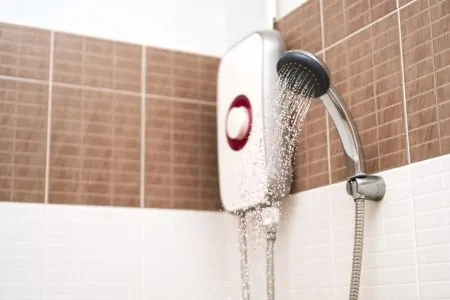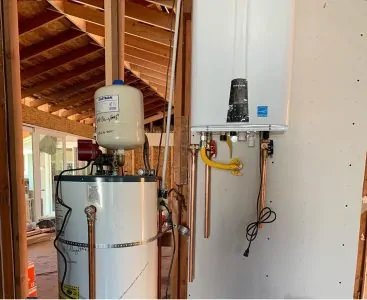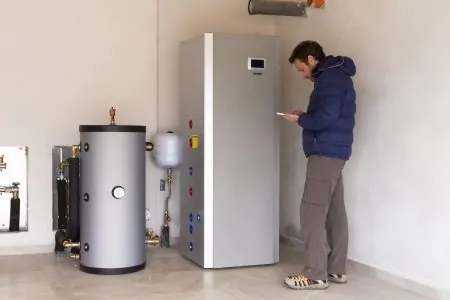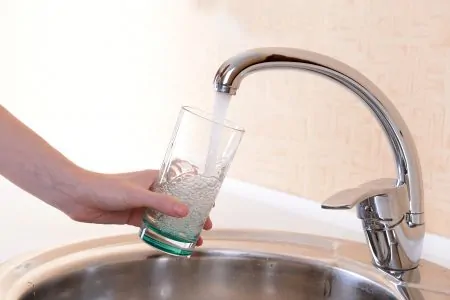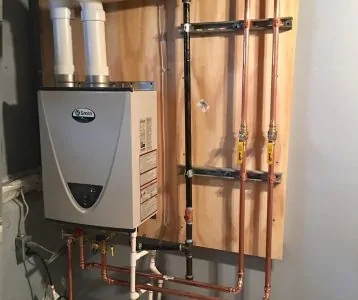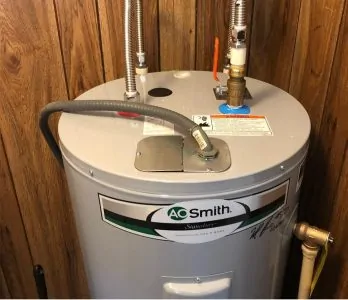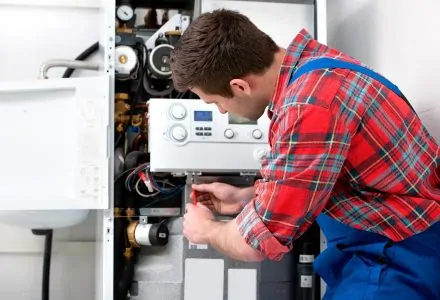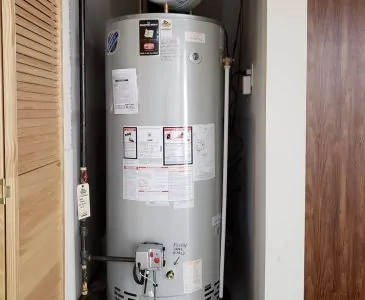Have you ever looked at a tankless water heater and wondered how such a compact machine produces so much hot water? Are you struggling to decide whether to go tankless or stick with a regular tank boiler?
There isn’t a universal answer to this question, which is why it’s important to understand how a tankless heater works. This will give you a better sense of whether or not a tankless heater is suitable for you.
In this article, we will take a closer look at what a tankless water heater is, as well as the advantages and possible drawbacks of using one.
Key Takeaways
- Tankless water heaters heat water on demand, eliminating standby heat loss.
- They come in whole-house and point-of-use varieties to suit different needs.
- Tankless heaters can be more energy-efficient and have a longer lifespan than traditional tank heaters.
- However, they may have a higher initial cost and may not provide enough hot water for simultaneous use in large households.
How Does a Tankless Water Heater Work?
Tankless water heaters function differently from regular tank-type units. A traditional heater consists of a tank and a heating method. These vary in size depending on how many gallons they can hold at once.
The water enters the tank and is heated by either electric elements or a gas-fired burner. The tank continuously heats its contents so you always have hot water when you need it. However, this results in something called “standby heat loss.”
The heater wastes energy by heating water that is left unused (1). In contrast, tankless units operate in a way that eliminates standby heat loss. Rather than heating and storing gallons of water, a tankless unit heats it on demand.
As there’s no tank, the cold water enters the unit through pipes, is heated, then leaves the unit hot. This is why they are often referred to as “on-demand” water heaters, but how does a tankless water heater work?
To produce hot water, the tankless heater features something called a heat exchanger. This is a powerful device that transfers heat from the fuel source to the water. Like a tank-type heater, a tankless generates heat through either a gas-fired burner or electric coils.
Where it differs is that the heat exchanger isn’t on all the time. It only activates when it senses sufficient water pressure. Some tankless units require high pressure, while others work with very little (2).
When the heat exchanger senses the appropriate pressure, it starts to heat the water as it passes through. It continues to heat the water flow to the specified temperature until you turn off the faucet.
How Different Tankless Systems Work
In the world of tankless water heaters, there are two broad categories of systems. These are whole-house, such as the Rinnai RUC98iN, and point-of-use, like the EcoSmart ECO 27. These systems fulfill two totally different requirements so it’s important to know the difference.
Whole-house units are large and powerful. They provide enough hot water for multiple outlets and are generally powered by natural gas or propane.
One common drawback of whole-house units is that they suffer from lag time. This is the time it takes for the hot water to travel from the heater to your faucet. In a large home, the lag time is significantly longer, which wastes water.
Point-of-use, on the other hand, works for one or perhaps two outlets. These units are compact and designed to be installed right where you need them, for example, under your sink. This reduces the lag time as the heated water only travels a short distance.
Point-of-use water heaters are typically powered by electricity. This also makes the installation much easier as there are no exhaust and venting requirements.
What to Expect From Tankless Water Heaters
With a standard tankless water heater, you can expect a flow rate of two to five gallons per minute (3). This depends on your unit and how large it is, as well as the power source.
Gas-powered water heaters generally deliver a higher flow of hot water than electric ones. However, even the most powerful gas-fired unit will struggle to provide a sufficient flow rate for simultaneous use in large homes. For example, taking a shower while running the dishwasher could be too much for it to handle.
Fortunately, there is one reliable solution: installing additional units to support your original one. Some models can be combined to fulfill a higher demand for hot water. Alternatively, you can simply install separate heaters in different parts of your home.
Benefits and Drawbacks
We have already mentioned a few advantages and disadvantages, but it’s worth digging a bit deeper. Especially as tankless water heaters aren’t suitable for everyone. Let’s start with the good points.
Benefits
- Efficiency: A tankless heater can be 8% to 34% more efficient than traditional units (4).
- Instant hot water: With tankless water heaters, the water is heated on demand. This eliminates long waiting times and standby heat loss.
- Longer service life: A traditional tank-type unit might last a decade. A tankless can last twice as long. This is because they aren’t exposed to the same level of corrosion caused by holding water for prolonged periods (5).
- Space-saving design: Some models are as small as a laptop, but even the largest tankless boiler is relatively compact and easy to fit into tight spaces.
- Endless hot water: As a tankless heater doesn’t use a tank, it can supply hot water indefinitely.
- Longer warranties: As tankless water heaters generally have a longer expected lifespan, their warranties are usually longer. Some manufacturers offer warranties of 20 years, others even longer.
Drawbacks
- High initial cost: Tankless water heaters typically have a higher initial cost than traditional units. They can also rack up a significant installation bill. However, they can reduce your monthly utility bills.
- Limited hot water: Although it can provide hot water indefinitely, a tankless heater isn’t ideal for simultaneous use. If you plan on running two or more appliances simultaneously, be prepared for some lukewarm or even cold water.
- Requires additional equipment: This varies from product to product, but most tankless heaters require you to buy extra equipment such as a water softener.
- Difficult to install: Again, this isn’t always the case. If you don’t already have the necessary pipes and vents in place, some re-routing may be required to install your new heater.
- Other ways to become efficient: Tankless water heaters are expensive to buy and might prove unnecessary for you. Sometimes, all you need are a few changes to your hot water habits to become more efficient.
- Requires more maintenance: Tankless water heaters require more maintenance, especially if you have hard water. You can expect to flush it at least once a year to every two years.
FAQs
Ready to Go Tankless?
Tankless water heaters work on demand, delivering hot water when you need it. Unlike a traditional unit, they don’t store water in a tank, thus eliminating the risk of standby heat loss. Instead, they heat the water as it circulates through the fitted heat exchanger.
Going tankless isn’t for everyone. If you have a large household that often runs hot water outlets simultaneously, a tankless unit might not be sufficient. However, you can overcome this by installing another unit as a point-of-use heater.
